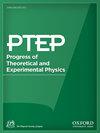Decays of standard model like higgs boson h → γγ, Zγ in a minimal left-right symmetric model
IF 8.3
4区 物理与天体物理
Q1 Physics and Astronomy
引用次数: 0
Abstract
Two decay channels h → γγ, Zγ of the Standard Model-like Higgs in a left-right symmetry model are investigated under recent experimental data. We will show there exist one-loop contributions that affect the h → Zγ amplitude, but not the h → γγ amplitude. From numerical investigations, we show that the signal strength μZγ of the decay h → Zγ is still constrained strictly by that of h → γγ, namely $|\Delta \mu _{\gamma \gamma }|<38\%$ results in max $|\Delta \mu _{Z \gamma }|<46\%$. On the other hand, the future experimental sensitivity $|\Delta \mu _{\gamma \gamma }|=4\%$ still allows |ΔμZγ| reaches to values larger than the expected sensitivity $|\Delta \mu _{Z \gamma }|=23\%$.极小左右对称模型中类似标准模型希格斯玻色子 h → γγ, Zγ 的衰变
根据最近的实验数据,我们研究了在左右对称模型中类似标准模型的希格斯粒子的两个衰变通道 h → γγ, Zγ。我们将证明存在影响 h → Zγ 振幅而不影响 h →γγ 振幅的一环贡献。通过数值研究,我们发现衰变h → Zγ的信号强度μZγ仍然严格受制于h → γ的信号强度μZγ,即$|\Delta \mu _{Z \gamma }|<38\%$ 结果为最大$|\Delta \mu _{Z \gamma }|<46\%$ 。另一方面,未来的实验灵敏度 $|\Delta \mu _{\Z \gamma }|=4\%$ 仍然允许 |ΔμZγ| 达到比预期灵敏度 $|\Delta \mu _{Z \gamma }|=23\%$ 更大的值。
本文章由计算机程序翻译,如有差异,请以英文原文为准。
求助全文
约1分钟内获得全文
求助全文
来源期刊

Progress of Theoretical and Experimental Physics
PHYSICS, MULTIDISCIPLINARY-PHYSICS, PARTICLES & FIELDS
CiteScore
12.00
自引率
5.70%
发文量
148
审稿时长
17 weeks
期刊介绍:
Progress of Theoretical and Experimental Physics (PTEP) is an international journal that publishes articles on theoretical and experimental physics. PTEP is a fully open access, online-only journal published by the Physical Society of Japan.
PTEP is the successor to Progress of Theoretical Physics (PTP), which terminated in December 2012 and merged into PTEP in January 2013.
PTP was founded in 1946 by Hideki Yukawa, the first Japanese Nobel Laureate. PTEP, the successor journal to PTP, has a broader scope than that of PTP covering both theoretical and experimental physics.
PTEP mainly covers areas including particles and fields, nuclear physics, astrophysics and cosmology, beam physics and instrumentation, and general and mathematical physics.
 求助内容:
求助内容: 应助结果提醒方式:
应助结果提醒方式:


